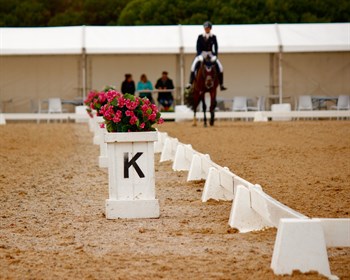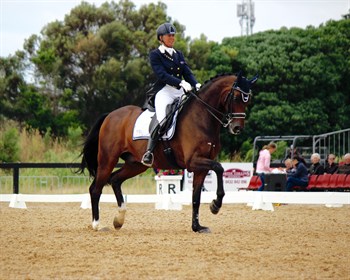
The Boneo arena looked a picture for the masterclass.
© Equestrian Life
In part one of her recap from Charlotte’s masterclass, Kerry covered the first two combinations - Charlie Welsh on her 5yo gelding Rubingold and Lizzie Wilson Fellows with HB Rhodium. Here, she looks at the remaining three riders.
CATCH UP ON PART ONE HERE.
By Kerry Mack
Jayden Brown has come from Queensland for this masterclass with Heather Adcock’s impressive 9-year-old black stallion, Legend of Loxley. Charlotte comments that she loves mares and has seven of them at present. She is not so keen on riding stallions herself.
‘You have to be quite diplomatic with stallions, especially in the breeding season,’ she says.
‘I always start with the canter work once they are warmed up, the canter improves the trot’. ‘Lazy horses need your legs off, hot horse need your leg on’. Not surprisingly, this was the same message that Carl Hester gave us. ‘Short reins win Gold Medals,’ she tells us. Well for some people anyway.
Jayden starts the canter work. ‘Travers in canter can supple the horse. The travers gives you bend in the neck, bend in the poll and bend around the inside leg, so bending in the ribcage. Now collect him in it, stay in travers and ride forward in it. This isn't in the test, but ride transitions within the movements in training’. ‘Test yourself by changing the tempo.’ ‘Not too much angle or he can’t get his inside hind leg under him’ (Jayden is still in travers).
In nearly every exercise, Charlotte is wanting variations; small transitions within the exercise, changes in the angle. She is continually wanting the horse to be responsive. She wants to develop suppleness and balance with these variations. Next she wants Jayden to ‘be brave’ and collect the canter using the transitions of longer steps and smaller steps in shoulder fore. ‘Ears up, back (collect). Now go travers, bend in the body. Now straight, now shoulder fore’.
The stunning Legend of Loxley and Jayden Brown at a previous event.
© Flash It Photography
Gosh this is nearly the same as George Morris last week. The next exercise is an oldy but a goody. Jayden takes a long diagonal line across the arena. Staying on the line, he starts in half pass, then flips the bend into leg yield, then flips the bend back into half pass. The line stays the same but the bending changes from left in the half pass, to right bend in the leg yield. And back to the half pass. This supples the horse. The lateral work alternates with riding forwards and straight. Uphill.
The audience is starting to appreciate how these suppling exercises could help produce a star like Valegro. When Legend tries to escape the collection, Jayden is asked just to persist. ‘Keep going, don't stop. Not more angle.’
The canter travers exercise is harder for this horse on the right, so Charlotte advises ‘to first take out the bend, then when he will, do quarters in with no bend then ask for bend’. ‘Keep the neck up’.
In the trot work once again. Leg into a softer hand ‘not driving into a block’. ‘Travers in trot, don't slow down. Keep it all the same (going in and out of travers). Shoulder in, turn the shoulders. Shoulder in to travers along the long side. Ears up, Really wrap him around your inside leg, keep him up and round without pulling. Now straight and uphill. The balance and rhythm mustn't change. Ride for and Eight’.
Charlotte gets Jayden to repeat the turning onto the centre line until it’s correct. Then the half pass. And the work is lovely. The horse makes a mistake. ’Don’t worry about it, don’t make him tense. Let him make a mistake and learn from it’. ‘Half halt and touch him with your leg’.
She wants Jayden to soften the rein after the half halt, before the leg is applied. The trot becomes more supple and expressive.
Abbie O'Brien and Rajah at the 2016 Dressage Nationals.
© Angie Rickard Photography
After the break Charlotte starts by emphasising the importance of the occasional ‘Yee-Hah”. When you use the leg he must be responsive. Whips are not allowed at championships, so the horse must respond to the leg without the whip. Abbie O’Brien and Rajah’s Rave are the next pair to benefit from Charlotte’s experience.
This combination are established at Prix St Georges. The lesson starts with improving the pirouette. ‘It must be controlled. Canter a circle, travers on the circle. Speed it up and slow it down in the travers, show a clear difference. Now shoulder fore on the circle. Make the canter short and bouncy, travers now shoulder fore, now travers, now shoulder fore. Now make the circle smaller. He mustn't fall on your inside leg. Now towards pirouette canter. Shoulder fore, now turn. Good (as he collects into the pirouette) and now allow him to go out into a bigger circle’.
And so the exercise is repeated on the other rein. Another good exercise to teach him to wait. Half pass, to X shoulder fore X to G on the centreline. Then half circle in travers, then half pass back to X. Keep his neck down as you turn the shoulders, rounder, the canter stays the same. This exercise can be as big or as small as she likes. Collect him but keep it quick with your leg (as he turns in the travers in the small half circle). Sit in the direction you are going. Quicker, not more speed, more jump. You don't want to practise test pirouettes every day he will start to take over. It is better to train these exercises. Then to the flying changes. ‘I always train the changes on the wall to keep them straight. Put the one that curls up against the wall. Keep his neck straight. Just move your legs. Ride the canter in between the changes. Bounce the canter up and down...Take a risk. That is the difference between the people who get the high marks. They take a risk’.
Abby gets to the one time changes and Charlotte wants her to go! To make the tempi changes bigger. Each time the horses in the masterclass earns a break, Charlotte insists on the transition to walk is well done and balanced. Then to the canter half pass zig zag. Leg yield left to the centreline then shoulder fore left on the centre one then change but stay straight in shoulder fore. He mustn't take over; not too much bend. When he waits and stays straight after the change, then he can do the leg yield back, like a leg yielding counter change of hand. Leg yield right, straight, shoulder fore, change straight in the shoulder fore and then leg yield left. Not bending. Only move the shoulders in the straight line; he has to wait. Just repeat it until he waits (Rajah is keen to do the half pass counter change of hand).
To finish, Charlotte asks Abbie to make more suspension in the trot, towards passage. Slow the front but not by pulling the neck in. Touch him on the top of the croup to get the hindquarters down - you have to find life and strength and balance. Round and loose. You have to ask; make it happen.
And Rajah finds a way to lift in the trot and becomes more elegant, the trot finds another gear. The audience is suitably impressed and appreciative.
Mary Hanna is next on her 9 year old Calanta by Johnson.
‘On this hot type of horse, the rider must be really loose’. The work starts again with the shoulder in. And again Charlotte wants it more forward: 'Try not to pull the neck in. Less bend and more forwards (in the shoulder in and half pass) Don't pull. Let go. Even if she runs on. Trot passage trot transitions, half halt and forward to the passage. Don’t pull. Don't pull the inside rein. Let go’.
Now transitions within the passage: ‘Quicker, more forward in the passage, play with it, adjust the tempo and the speed of the passage. Training can make the horse adjustable so the transitions in the test are easier. Use the wall to keep her straight. Let the neck lower'.
This beautiful mare certainly has a great ability for this collected work. As the sun gets lower (it's 9pm) and it's getting cold, Charlotte gets on this beautiful mare to show us what she means. Immediately Charlotte’s core strength is apparent. The rhythm in the trot is metronomic. ‘I will sit heavy and relax down, a nice even feeling in both reins. With my reins I balance her. My leg hangs loose. She isn't in front of my leg yet’.
She emphasises the need to let go with the rein and put the leg on with this hot horse. You have to be brave to ride like this. It is hard to resist the urge to pull on the rein and take the leg off on the hot horse, but this intuitive reaction is totally the opposite to what Charlotte wants. And Calanta seems to appreciate the confidence of Charlotte's riding. Even in the half dark the audience can see that the mare is longer in the frame, more supple, more elevated, more collected.
Beautiful, supple, forward half passes are the result. ‘When she stiffens I half halt and soften her. I shake her off the bit. I don't want to hold her’. Charlotte does the leg yield at canter. ‘If she is stiffer to the right I bend her to the right and soften’.
And then the changes. Charlotte uses the wall and does two tempi changes along the long side working on the softness. Then a one time change. Then 4 one times, in the nearly dark. ‘I just put her in the right balance and she has to do the work’. This is a superstar horse in Charlotte’s hands. It looks easy.
This is the tantalising secret of good dressage. It looks like the rider does nothing. Everybody watching can imagine themselves sitting on the horse doing nothing! If only it were that easy.
And then we see the first stars in the sky the evening draws to a close. Charlotte was not afraid to insist that riders do what she said. This insistence that things be done right, the insistence on balancing and letting go, I think is the same fastidiousness that makes her World Champion. No doubt she is at least as tough on herself as she was on our riders. There was nothing new. No secrets, not even a new exercise. But a reminder about the basics, about the need to balance and let go. The need to use the lateral work and an infinite number of transitions to develop the balance.
The next morning I was out there practising what we saw. That is her real challenge. To see and understand how she produces suppleness and lightness and take it into our own riding. Have fun!
Mary Hanna, pictured here on Sancette on their way to second place in the Grand Prix at Boneo.
© Equestrian Life
READ THE LATEST NEWS ARTICLES HERE
https://www.equestrianlife.com.au/articles/Kerry-Mack-reports-from-the-Charlotte-Dujardin-Masterclass-Part-Two_




